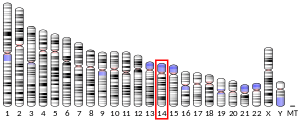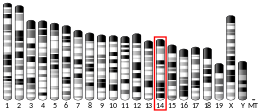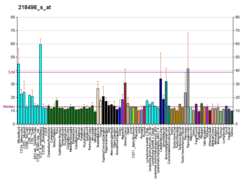ERO1L
ERO1-like protein alpha is a protein that in humans is encoded by the ERO1L gene.[5][6]
Interactions
ERO1L has been shown to interact with TXNDC4[7] and P4HB.[7][8]
gollark: See, I don't get randomly angry or something. Make me moderator.
gollark: I said they were! I didn't say they weren't! You're interpreting me oddly!
gollark: You are clearly a most 1337 h4xx0r.
gollark: What did you do, put the instruction in a weird form? Offset it by some weird number of bytes?
gollark: It's technically *possible*.
References
- GRCh38: Ensembl release 89: ENSG00000197930 - Ensembl, May 2017
- GRCm38: Ensembl release 89: ENSMUSG00000021831 - Ensembl, May 2017
- "Human PubMed Reference:". National Center for Biotechnology Information, U.S. National Library of Medicine.
- "Mouse PubMed Reference:". National Center for Biotechnology Information, U.S. National Library of Medicine.
- Cabibbo A, Pagani M, Fabbri M, Rocchi M, Farmery MR, Bulleid NJ, Sitia R (February 2000). "ERO1-L, a human protein that favors disulfide bond formation in the endoplasmic reticulum". The Journal of Biological Chemistry. 275 (7): 4827–33. doi:10.1074/jbc.275.7.4827. PMID 10671517.
- "Entrez Gene: ERO1L ERO1-like (S. cerevisiae)".
- Anelli T, Alessio M, Mezghrani A, Simmen T, Talamo F, Bachi A, Sitia R (February 2002). "ERp44, a novel endoplasmic reticulum folding assistant of the thioredoxin family". The EMBO Journal. 21 (4): 835–44. doi:10.1093/emboj/21.4.835. PMC 125352. PMID 11847130.
- Mezghrani A, Fassio A, Benham A, Simmen T, Braakman I, Sitia R (November 2001). "Manipulation of oxidative protein folding and PDI redox state in mammalian cells". The EMBO Journal. 20 (22): 6288–96. doi:10.1093/emboj/20.22.6288. PMC 125306. PMID 11707400.
Further reading
- Pagani M, Fabbri M, Benedetti C, Fassio A, Pilati S, Bulleid NJ, Cabibbo A, Sitia R (August 2000). "Endoplasmic reticulum oxidoreductin 1-lbeta (ERO1-Lbeta), a human gene induced in the course of the unfolded protein response". The Journal of Biological Chemistry. 275 (31): 23685–92. doi:10.1074/jbc.M003061200. PMID 10818100.
- Benham AM, Cabibbo A, Fassio A, Bulleid N, Sitia R, Braakman I (September 2000). "The CXXCXXC motif determines the folding, structure and stability of human Ero1-Lalpha". The EMBO Journal. 19 (17): 4493–502. doi:10.1093/emboj/19.17.4493. PMC 302061. PMID 10970843.
- Pagani M, Pilati S, Bertoli G, Valsasina B, Sitia R (November 2001). "The C-terminal domain of yeast Ero1p mediates membrane localization and is essential for function". FEBS Letters. 508 (1): 117–20. doi:10.1016/S0014-5793(01)03034-4. PMID 11707280.
- Mezghrani A, Fassio A, Benham A, Simmen T, Braakman I, Sitia R (November 2001). "Manipulation of oxidative protein folding and PDI redox state in mammalian cells". The EMBO Journal. 20 (22): 6288–96. doi:10.1093/emboj/20.22.6288. PMC 125306. PMID 11707400.
- Anelli T, Alessio M, Mezghrani A, Simmen T, Talamo F, Bachi A, Sitia R (February 2002). "ERp44, a novel endoplasmic reticulum folding assistant of the thioredoxin family". The EMBO Journal. 21 (4): 835–44. doi:10.1093/emboj/21.4.835. PMC 125352. PMID 11847130.
- Tsai B, Rapoport TA (October 2002). "Unfolded cholera toxin is transferred to the ER membrane and released from protein disulfide isomerase upon oxidation by Ero1". The Journal of Cell Biology. 159 (2): 207–16. doi:10.1083/jcb.200207120. PMC 2173060. PMID 12403808.
- Gess B, Hofbauer KH, Wenger RH, Lohaus C, Meyer HE, Kurtz A (May 2003). "The cellular oxygen tension regulates expression of the endoplasmic oxidoreductase ERO1-Lalpha". European Journal of Biochemistry. 270 (10): 2228–35. doi:10.1046/j.1432-1033.2003.03590.x. PMID 12752442.
- Clark HF, Gurney AL, Abaya E, Baker K, Baldwin D, Brush J, Chen J, Chow B, Chui C, Crowley C, Currell B, Deuel B, Dowd P, Eaton D, Foster J, Grimaldi C, Gu Q, Hass PE, Heldens S, Huang A, Kim HS, Klimowski L, Jin Y, Johnson S, Lee J, Lewis L, Liao D, Mark M, Robbie E, Sanchez C, Schoenfeld J, Seshagiri S, Simmons L, Singh J, Smith V, Stinson J, Vagts A, Vandlen R, Watanabe C, Wieand D, Woods K, Xie MH, Yansura D, Yi S, Yu G, Yuan J, Zhang M, Zhang Z, Goddard A, Wood WI, Godowski P, Gray A (October 2003). "The secreted protein discovery initiative (SPDI), a large-scale effort to identify novel human secreted and transmembrane proteins: a bioinformatics assessment". Genome Research. 13 (10): 2265–70. doi:10.1101/gr.1293003. PMC 403697. PMID 12975309.
- Anelli T, Alessio M, Bachi A, Bergamelli L, Bertoli G, Camerini S, Mezghrani A, Ruffato E, Simmen T, Sitia R (October 2003). "Thiol-mediated protein retention in the endoplasmic reticulum: the role of ERp44". The EMBO Journal. 22 (19): 5015–22. doi:10.1093/emboj/cdg491. PMC 204474. PMID 14517240.
- Bertoli G, Simmen T, Anelli T, Molteni SN, Fesce R, Sitia R (July 2004). "Two conserved cysteine triads in human Ero1alpha cooperate for efficient disulfide bond formation in the endoplasmic reticulum". The Journal of Biological Chemistry. 279 (29): 30047–52. doi:10.1074/jbc.M403192200. PMID 15136577.
- Molteni SN, Fassio A, Ciriolo MR, Filomeni G, Pasqualetto E, Fagioli C, Sitia R (July 2004). "Glutathione limits Ero1-dependent oxidation in the endoplasmic reticulum" (PDF). The Journal of Biological Chemistry. 279 (31): 32667–73. doi:10.1074/jbc.M404992200. PMID 15161913.
- van Lith M, Hartigan N, Hatch J, Benham AM (January 2005). "PDILT, a divergent testis-specific protein disulfide isomerase with a non-classical SXXC motif that engages in disulfide-dependent interactions in the endoplasmic reticulum". The Journal of Biological Chemistry. 280 (2): 1376–83. doi:10.1074/jbc.M408651200. PMID 15475357.
- May D, Itin A, Gal O, Kalinski H, Feinstein E, Keshet E (February 2005). "Ero1-L alpha plays a key role in a HIF-1-mediated pathway to improve disulfide bond formation and VEGF secretion under hypoxia: implication for cancer". Oncogene. 24 (6): 1011–20. doi:10.1038/sj.onc.1208325. PMID 15592500.
- Otsu M, Bertoli G, Fagioli C, Guerini-Rocco E, Nerini-Molteni S, Ruffato E, Sitia R (2006). "Dynamic retention of Ero1alpha and Ero1beta in the endoplasmic reticulum by interactions with PDI and ERp44". Antioxidants & Redox Signaling. 8 (3–4): 274–82. doi:10.1089/ars.2006.8.274. PMID 16677073.
This article is issued from Wikipedia. The text is licensed under Creative Commons - Attribution - Sharealike. Additional terms may apply for the media files.




